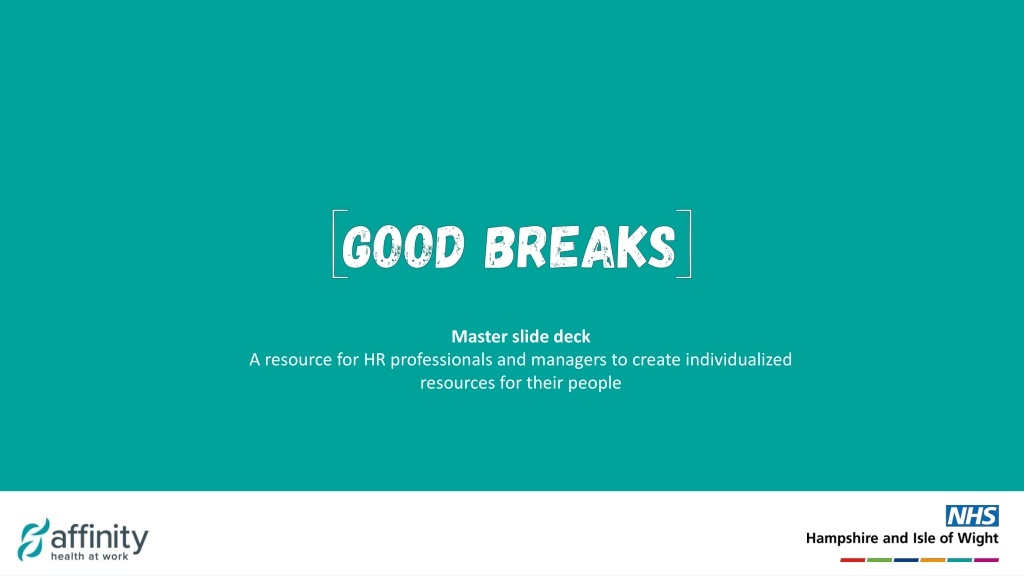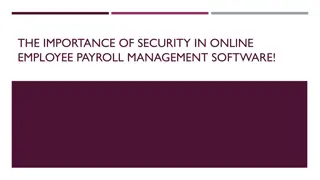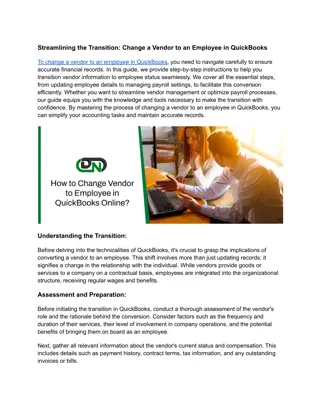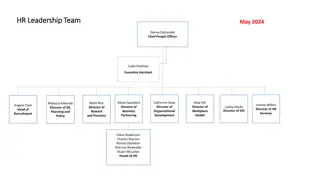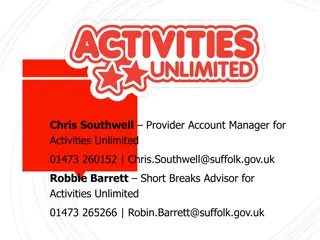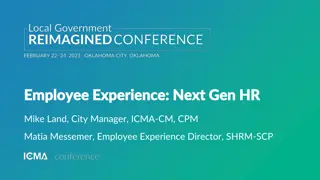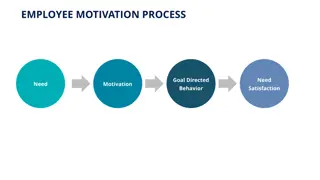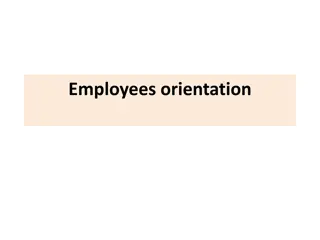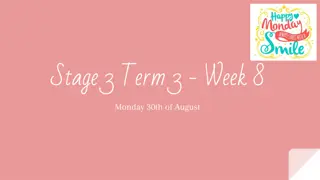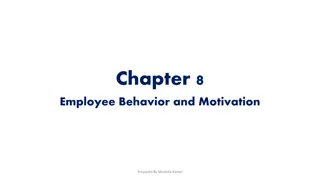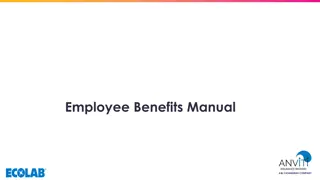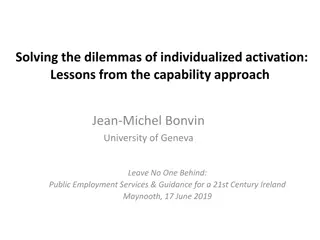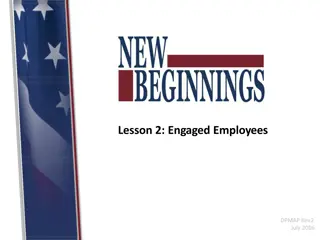Creating Individualized Resources for Employee Breaks in HR Management
Providing a master slide deck resource for HR professionals and managers to tailor individualized break strategies for their teams. The content covers the importance of breaks, ways to encourage and optimize breaks, and strategies at the individual, group, leader, and organizational levels. Breaks are highlighted as crucial for mental and physical health, reducing absenteeism, turnover, and enhancing patient safety and job retention. Practical tips and examples are included for promoting effective breaks in different work settings.
Download Presentation

Please find below an Image/Link to download the presentation.
The content on the website is provided AS IS for your information and personal use only. It may not be sold, licensed, or shared on other websites without obtaining consent from the author. Download presentation by click this link. If you encounter any issues during the download, it is possible that the publisher has removed the file from their server.
E N D
Presentation Transcript
Master slide deck A resource for HR professionals and managers to create individualized resources for their people
This slide deck has been developed as a master deck for use across HIOW. Guide to this deck The content in this deck has been used for the webinar series and has been provided here in the full form to allow you to cut and deliver segments depending on your need. Why do people not take breaks?
Overview of resources Introduction Individual Group Leader Organisation Outside
Content of the master deck SECTIONS HEADLINES Slide number Why breaks are important Why we don t take breaks How we can make breaks happen taking a shared responsibility INTRODUCTION When scheduling What optimizing break activities How changing behaviour WHAT GOOD BREAKS LOOK LIKE When and how long to take a break Strategies for rest and recovery Overcoming obstacles Examples tailored to staff groups shift workers, desk-based workers, home-workers, community I WHAT CAN WE DO FOR OURSELVES Role modelling Checking in Breaking social norms G WHAT WE CAN DO FOR EACHOTHER Strategies for goal setting and behaviour change Role modelling Opportunities and permission Managing and monitoring Signposting to resources Examples tailored to staff groups shift workers, desk-based workers, home-workers, community L WHAT CAN MANAGERS DO Workload and prioritization Culture Space Evaluation O WHAT CAN THE ORGANISATION DO Spaces and walking routes around sites O MAKING THE MOST OF OUTSIDE RESOURCES
Why are breaks important? Breaks can help us recover from the day to day demands and pressures of our work and in turn, Mental Health Physical Health Absenteeism Turnover Patient Safety Longer breaks resulted in better patient safety, fewer medication errors and fewer falls with injuries among patients through improved nursing care Over 9 in 10 employees were more likely to stay at a job if their managers encouraged people to take a break Restore energy and decrease the development of fatigue, sleep disorders and cardiovascular disease 94% of employees said they felt they had a fresh perspective on work after taking a break Taking regular breaks protects against exhaustion, stress and accidents, and in turn, reduces sick leave
What staff say 69% of nursing staff do not take breaks, compared to 56% of hospital staff 65% said they worked additional time, on average almost one hour extra 59% said they did not get to take sufficient breaks on their last shift 8+ hour shifts carry an increased risk of accidents with twice the risk of accidents at around 12 hours compared to 8 hours NHS staff are entitled to a minimum break of 20 minutes if working longer than 6 hours Breaks should be uninterrupted, away from the workstation, not taken at the start or end of the working day 2017 Borneo et al. RCN
What staff say The physical working environments are often not fit for purpose. There are no windows, no heating. People feel guilty taking their break as it means leaving others even more short staffed, therefore they are often not eating, moving or hydrating well. There is a need for managers to reinforce a rest culture, and show they also take breaks seriously I miss talking to my colleagues now it is all work We often snack on convenience food during breaks, knowing it is not healthy, but it is hard to eat well.
HIOW research shows people struggle to take breaks because of: Thoughts, feelings and behaviour Culture Workload Work environment Why do people not take breaks? Resourcing Scheduling & planning NHS research shows that 22% of people feel judged when they take a break from work (Turk, 2020) We have designed the GOOD BREAKS resources to help you to challenge some of these barriers to taking a good break.
What good breaks look like When What - How What we can do for ourselves and each other
How When What Igloo Woop Dramma Time tactics Conversations Rest Eat and drink Surroundings Exercise Time together
When When and how long to take a break factors to consider when scheduling breaks
When - Scheduling & Duration The most The most productive people productive people work for work for approximately 40 approximately 40- - 50 minutes 50 minutes straight & then straight & then take a break. take a break. Breaks are needed so we can cycle between focus and recovery Where possible, Consult with others on when breaks are preferred For longer days, particularly when sitting behind the computer, schedule breaks earlier in the day Take more short breaks throughout the day, rather than fewer long breaks.
How long to take a break Micro breaks Lunch/Rest breaks Longer breaks Help us to maintain focus and prevent fatigue Ideally: Regular short breaks of around 5 or 10 minutes Important we can choose our own Recovery activities inculde hydrating, as having a snack, a toilet break, social connection or having a walk or a stretch Help us to destress and re- charge for the rest of workday. They can increase job satisfaction, productivity, mental well-being and boost creativity Ideally: 40 mins More time for health habits including healthy lunch, exercise, meditate, walk Regular longer breaks such as days off, weekends and holidays help us to replenish our resources Ideally: Regular weekend/mini breaks are better than longer holidays with long gaps between them Important to have cover so that you don t return to a big workload and cancel out the benefits.
RESET during your break to make it a healthy break
Rest Eat and drink Surroundings Exercise Time together R E S E T
Rest Having rest and recovery time during a break is important, whether you are on your feet all day or sitting at a desk. Rest looks different to everyone. It can include: A sit down with your feet up or a nap Some quiet time away from a noisy work environment A catch up with a friend Meditation or mindfulness Think about what is important to you?
Eat and drink There is a lot of evidence linking food and nutrition to gut health, overall physical health and mental health, energy levels and concentration. Some helpful habits regarding food and nutrition Eat protein early in the day Eat lots of fruit and vegetables Reduce sugary and processed foods Eat regular, small healthy snacks What habits around eating and drinking could you build into your good break?
Surroundings Our surroundings have a big impact on how well we rest and recover. INSIDE consider seating or beds, fresh air, daylight, space to store or purchase food and drink. OUTSIDE consider green space, walking routes, seating areas or exercise equipment. Where is your preferred surrounding?
Exercise Moving during your break has been found to have a positive impact on: Memory and thinking Self-esteem Sleep Energy levels Relieves stress Resilience
Exercise walking breaks Did you know that even a moderate walk can increase your brain activity? Increased accuracy, attention, cognitive processing Regular exercise leads to an improvement in neurological health and reduces the risk of burnout symptoms (Deloitte Neuroscience Institute)
Time together Talking is one of the most efficient Talking is one of the most efficient recovery methods recovery methods Several studies have found that spending time with others has a positive impact on wellbeing and energy. Social support reduces the impact of work demands Social activities allow you to switch off from work focus Helps to keep an eye on who am I when I am not working .
Break outcome type of activity Higher motivation & engagement Higher performance More energy and vigor Better mood Relaxing Learning something new Detachment from work Social activities Physical activities Sleep/napping Learning something new Relaxing Social activities Physical activities Detachment from work Social activities Physical activities Sleep/napping Social activities Physical activities
Rest Eat and drink Surroundings Exercise Time together R E S E T
How do we make good breaks happen? Strategies needed for rest and recovery to protect mental health and well-being
Changing the way staff rest and recover from work needs a systems approach. People can impact change at different levels in an organisation to make a positive difference. The IGLOO framework helps us look at the whole system: the Individual, the Group, the Leader and the Organisation and the Outside world. The IGLOO helps us understand the different responsibilities for taking a good break at each level Taking a shared responsibility by building an IGLOO for good breaks Level Responsibility to Understand and take action to maintain health and work needs Voice and share needs appropriately to access to breaks Individual Behave considerately towards others Advocate and support of colleagues Check in and role model good breaks Group Behave in a way that promotes and protects health Role model Monitor and take action to provide break opportunities consistently Signpost support where needed Line manager Provide access to policies and monitor consistency of practices within local areas Develop employees with the knowledge and skills to fulfil their responsibilities Monitor and take action to develop opportunities for all staff to take breaks Organisation Community spaces and local areas Outside
WOOP your breaks Wish Outcome Obstacles Plan
Create some DRAMMA Detachment - Tools such as boundaries, rituals and journaling Recovery Rest, take a break, and do something different Autonomy - Do something you choose to do, rather are told to do Mastery - Do something that you are good at Meaning - Do something that is important and valuable to you Affiliation - Build social relationships and gain a sense of belongingness Newman et al., 2014
Use a TIME TACTICS Monk mode Pomodoro technique To-think lists Goalden hour Productivity partner Time blocking Music mindset
Talk about breaks with your manager & colleagues Talk about: How you work at your best When and how you need to take a break during the day 22%of workers feel judged when taking a break from work in the middle of the day Over 9 in 10 employees were more likely to stay at a job if their managers encouraged people to take breaks This will help to: Set expectations Role model to others around you that breaks are an important part of the working day Work well and stay well
Three ways to help your colleagues take a good break
Three ways to support your colleagues Role model Check-in Break the norms Talk about breaks and find out about needs and preferences Suggest ideas Shall we have lunch together or I m going to take my lunch outside today, what are you doing? Look out for signs and signals and support others in taking their break Don t normalise bad break practices (eg. that is just the way it is around here) Avoid rewarding bad breaks practices (eg. they're such a trooper, they never stop!) Incorporate breaks into work as normal - when talking to new staff and work planning Take your breaks - micro breaks, lunch breaks, holiday Set boundaries and keep them schedule breaks, don t respond to emails OOO Talk about how you RESET - let others know what you are doing in your breaks
Three ways managers can support good breaks
1. Role modelling good breaks But people who believe that taking breaks have a positive impact are more likely to take them Take your breaks - put your own oxygen mask on before helping others Less than half of managers think that work breaks can improve their own performance Seek out opportunities to RESET Rest, Eat&Drink, Surroundings, Exercise and Time together Talk about breaks - Make break- taking part of the conversation
2. Use EAST to change break-taking behaviour Schedule breaks so there is clarity when staff can take their break, what the etiquette is, what cover is arranged Make breaks predictable and part of their routine Give permission for people to RESET Raising awareness of how breaks can benefit wellbeing Understanding different needs in the team (eg need for walk, gym, creative space, quiet sit down) Make sure people have breaks before they get exhausted, hungry or thirsty Remind people to take thier breaks Can you arrange for people to have breaks together? Easy Timely Easy Attractive Social Attractive Timely Social
3. WOOP your teams breaks Wish Outcome Obstacles Plan
How can OD/HR professionals help good breaks happen Policies and practices that support good breaks
Lead a culture change Breaks just happen around here, no need and too much to do Making break-taking a priority will require culture change To make breaks part of everyday routines, consistently we need to take all individuals on a journey I take breaks regularly A break might help, I am exhausted I missed my break because it was too busy I plan to go on a walk at lunchtime.. I m on my walk
Supporting Good Breaks as an Organisation The following actions could help to ensure good breaks happen: The following actions could help to ensure good breaks happen: Review policies and procedures Review policies and procedures on breaks to ensure they are easy to follow and are being followed consistently Consider breaks in wider decisions, Consider breaks in wider decisions, when looking at resourcing, workload, task prioritization Provide managers with support Provide managers with support and guidance to help make breaks happen Create and maintain appropriate break spaces & facilities Create and maintain appropriate break spaces & facilities Light, Ventilation, Quiet, Space to sit or lie down, Space to eat and drink, Storage of food and drink, Available healthy food to purchase Monitor and Evaluate the impact of break taking Monitor and Evaluate the impact of break taking behaviour Retention, absence, staff wellbeing and engagement, Mental and physical health, patient safety Keep sharing good practice Keep sharing good practice and keep up to date on guidance behaviour
Learnings for a successful implementation Implementation Learnings - What works best? What What Multiple options to allow people to take their own good break Where and when Where and when In work, in work time Engagement Engagement Support from line managers and colleagues Delivery Delivery Trusted sources, responsive to need Design Design Bespoke to format, to fit different roles Communication Communication Multiple avenues, multiple occasions Resources Resources Protected budgets, staff pressures well managed 42
Benefits of good sleep Hungrier and more likely to eat Good sleep is associate with Social wellbeing Physical health Emotional control High levels of creativity Decision-making ability Memory consolidation Suffer more loss of memory or ability to concentrate Not looking your best Just one night Just one night of lost sleep is of lost sleep is associated associated with.. with.. More likely to be emotional More likely to have an accident More likely to catch a cold or other ailment Losing brain tissue
Getting a better night sleep Avoid caffeine, alcohol, nicotine Focus on sleep supportive foods Balance fluid intake Lighten up on evening meals Switch off technology in the evening Use light to your advantage Nap early or not at all Exercise early Bedroom into sleep-inducing environment Go to bed when you are tired Establish a soothing pre- sleep routine Consistent sleep schedule
Sleep Sleep - - the basics the basics How sleep works How our sleep cycles work Good sleep habits start with exposure to morning sunlight, because it Most of us need between 7-9 hours sleep a night Age, genetics and many other factors influence how much sleep we need Sleep occurs in cycles (typically 90 minutes each) and all stages of sleep are necessary to keep us well. regulates circadian rhythms and encourages good sleep promotes early cortisol release which drives focus and alertness, sets off the metabolic system, and is good for our immune response elevates mood Aim to: : get outside within 30-60mins of waking view morning sun for 5-10mins on sunny days and 15-20mins on overcast days don t need to view directly, do as you feel comfortable Stage 1 non-REM sleep: changeover from wakefulness to sleep Stage 2 non-REM sleep: light sleep before you enter deeper sleep Stage 3 non-REM sleep: restorative deep sleep that you need to feel refreshed in the morning REM sleep: first occurs about 90 minutes after falling asleep. Most of your dreaming occurs during REM sleep, and your arm and leg muscles become temporarily paralysed to prevent you from acting out your dreams.
Good Sleep Habits 10 top tips Nighttime routines that promote better sleep 7. Get the temperature right: Our body temperature begins to drop during sleep to conserve energy. Keeping your room cool at night signals to the body that bedtime is approaching. Aim for around 18 degrees Celsius. Cool showers before bed can help too. Daily habits that promote better sleep 1. Fix your wake-up time: Try to keep the time you wake up consistent during the week and at the weekend. A fluctuating schedule disrupts your sleep rhythms. 8. Wind-down routine: 60-minute wind-down routine 20 minutes of closing down tasks and reflecting on the day 20 minutes of hygiene practices like brushing and getting ready for bed 20 minutes of relaxation through reading, meditation or breathing practices. 2. Get morning sunlight: Sunlight tunes our body clock. Going outside within 30-60 minutes of waking helps to regulate our sleep-wake cycles. 9. Unplug from electronics: Aim to go tech-free 60 minutes before bedtime. Cell phones, tablets, and laptops cause mental stimulation that is hard to shut off. Electronics also generate blue light that may decrease production of the hormone melatonin which is vital for sleep. 3. Cut down on caffeine in the afternoon and evening: Avoid caffeine within 8-10 hours of bedtime, as it can take up to 12 hours before caffeine is fully metabolised. 4. Keep naps short: Long naps can disrupt a good night s sleep. To avoid this, keep naps relatively short (10-15 minutes) and try not to nap later than 2 pm. 10. Block out light and noise: Use heavy curtains or an eye mask to prevent light from interrupting sleep. Having a bedroom that is not dark enough can disrupt the sleep cycle because light suppresses melatonin. 5. Reduce alcohol consumption: Regulate drinking late in the evening, as alcohol can lower your overall sleep quality. 6. Prioritise Sleep: Don t skip sleep in order to work or socialise. Calculate a target bedtime based on your fixed wake-up time and do your best to be ready for bed around that time each night.
Good breaks look different Considerations and strategies for different staff groups
Individual differences and preferences and different staff groups have different needs Good Breaks can look different for everyone Staff on wards Desk based staff Home based staff/hybrid workers Staff doing shift patterns/night shifts
Good break tips for ward based and non-office based staff For staff on the wards and those on their feet all day, a break is an opportunity to sit down, rest and have something to eat or drink. It is important to think about whether indoor and outdoor spaces provide somewhere for: A comfortable to sit down Quiet Access to a phone or computer Access to food/drink/kitchen facilities
